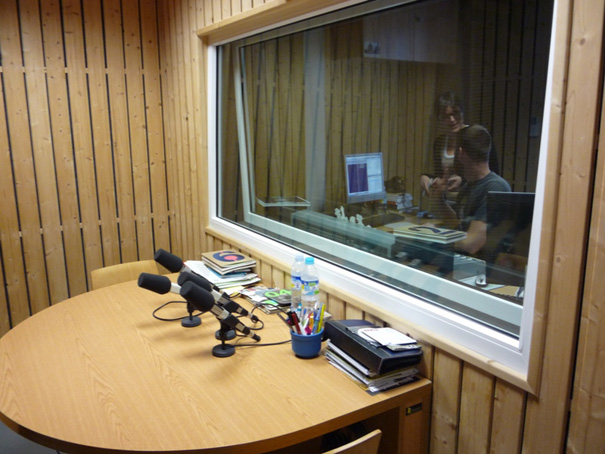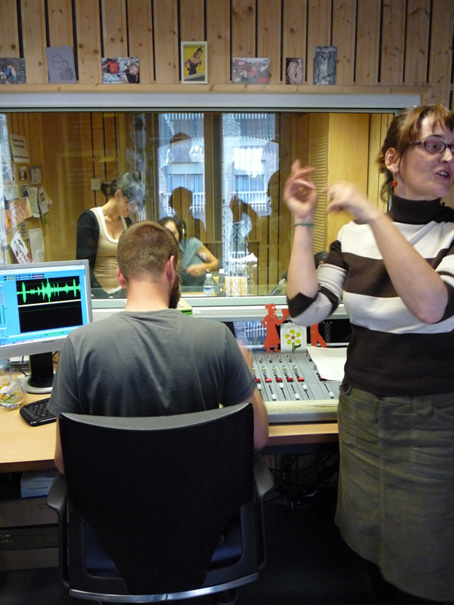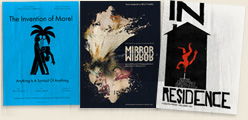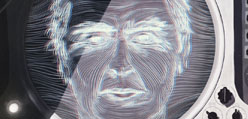Radio Theater:
Caben todos los ruidos

All Photographs by Alexandra Atiya
In Pontós, a small town in the forests of Cataluña, Ángeles Oliva and Toña Medina put together their first true “RadioPerformance.”
They had been asked to be artists-in-residence at Festival MAPA, a festival which uses the dramatic setting of Pontós to provide inspiration for the actors, visual artists and performers who come each September. Ángeles and Toña were the first radio presenters ever to be invited.
Following the suggestion of “night,” as the artists’ topic, they developed a performance piece about fear that combined their medium — radio — with elements of theater.
The show, called “Caben todos los ruidos” — “All the noises fit” — was a departure from their typical work. Formerly, they were both presenters for a Spanish national radio station. Now they are the producers of a weekly radio show for a cultural center in Madrid, and the directors of workshops and an experimental radio lab at the same center. They started working together in 2002, so they had always used computers to produce their shows.
In Pontós, they worked without computers. They had to perform in front of a live audience. The stage was full of unforgiving objects: green balloons, a talking doll, a megaphone, several tape recorders, a pitcher of water, an empty piece of wood and many other curiosities that they had collected to make the sounds of their performance.
The set was otherwise spare. Ángeles and Toña were onstage, but they were asking the viewers to retreat to a visual world as private and individual as they might enjoy when listening to the radio.
You can see pieces of “Caben todos los ruidos” on Youtube or Ángeles’s and Toña’s blog.
The performance had four parts. The first part addressed fears particular to women. Much of it was about women’s fear of being attacked, or mistreated by men, though none of it centered on particularly dramatic events.
Instead, Ángeles and Toña told stories, or pieces of stories, about women and men, and used live sounds to create an ambience. For example, a set of keys jangling implied fear when coming home late at night. In high heels Ángeles walked across a piece of wood, creating the sound of lonely steps on a dark street.
Ángeles told a story about a man who grabbed a girl’s bottom — Toña burst a balloon. As the man, according to Ángeles, started to yell, Toña gripped another balloon, making the rubber scream.
“Some of the sounds are more descriptive, others are more metaphorical,” Ángeles said. “But they all try to arrive at a certain feeling.”
In the second part, a local woman, whose voice had been pre-recorded, told a scary story passed down from her grandfather: the story of a goat that turned into a monster. Ángeles and Toña then expanded upon that story, with some humor.
In the third part, they mixed up phrases and slang meant to show men’s fearlessness. For example: “Don’t fall in love with me.”
“I’m not going to the doctor, man, I can stand it. It’s just pain.”
“If I said no, then it’s no. Because I said so.”
In the final part Ángeles and Toña retired to two rocking chairs. An old-fashioned radio sat between them. The lights dimmed, and the voices of elderly residents of Pontós came over the radio. They talked about what they are afraid of: among others, one man said he was afraid of nothing and a woman said she was afraid of death.
Underneath their voices were the soft sounds of Pontós itself—the sound of a stream, and the sound of animals. The sound faded out, and then Toña switched off the lamp that sat between them.
It was a short show—it lasted about 35 minutes.
They performed the piece twice at Festival MAPA in Pontós, then twice in Madrid, and once more at a theater festival in Castilla-la Mancha.
The MAPA website describes their project as “its first incursion into the radio world, provoking a direct encounter between those who make radio and those who listen to it.”
I asked Ángeles if the show could be understood without the visual element. She thought for a moment and then said, “Well, yes, I think it would make sense with just the sound alone. I think so. It was conceived of that way.”
“I think it’s radio. It’s radio on a stage,” she added. “Moreover, our concern was that people understand that it was radio.”
“We’re not professionals of the stage. We aren’t. We always think first about the sound.”

“WHEN SOMEONE COVERS YOUR EYES”
In 2007, a year before they developed “Caben todos los ruidos,” Ángeles and Toña produced a project in the patio of La Casa Encendida, the cultural center where they work.
The project was called “Cuando alguien te tapa los ojos” — “When someone covers your eyes.”
Visitors were invited into the patio. The floor was covered in cushions. Audience members could either sit on the floor or in chairs along the side of the patio. Each visitor was given a blindfold.
Audience members could choose to wear the blindfold, or to take it off during the course of the performance.
If they took off their blindfolds, they saw Ángeles and Toña interpreting some of the pieces.
There were five pieces in total, one produced by Ángeles and Toña, and four produced by others, not all Spanish. One Argentine group contributed a piece which can be heard here, and can give you some idea of how the general topic — “when someone covers your eyes” — was explored through a combination of sound effects, fiction and reporting.
Unlike “Caben todos los ruidos,” most of the work for this project was pre-recorded. Ángeles and Toña only invented the physical interpretation.
“Afterward people told us that they liked it. They liked to see this kind of choreography,” Ángeles said. After that, she said, they were interested in expanding the possibilities for performance.
Both Ángeles and Toña were emphasized the fact that they didn’t have any experience working in theater or any other visual medium. Still, Ángeles said that “everyone has in their head a ton of things that every day we are watching or listening to,” and that those things can make an impression.
“I grew up watching films,” Toña said, “that’s the truth. But Ángeles and I aren’t the same. We have very different tastes.”
House on fire
Ángeles and Toña met first in a master’s program for radio in 2001. They started to work together at Radio 3 the following year.
In December 2002, La Casa Encendida opened in Madrid. La Casa Encendida has no exact equivalent in New York. It hosts theater and dance performances, films, exhibits of art, video and photography, as well as workshops and lectures about art, the environment and other issues. It sponsors classes in languages and computer skills, and has an open library. It’s part of the legally-mandated Obra Social (public work) of the Caja Madrid, the province’s main savings bank and one of Spain’s largest financial institutions. Ángeles and Toña proposed a project for radio at La Casa Encendida at its inception.
Now their work there has three main parts, apart from the newly-developed radio performances. They produce Cápsula, an hour-long program that includes interviews with curators and artists, clips from concerts that week, ambient sounds of the space itself (for example, an exhibit being installed, or people laughing on the terrace), and short interviews with visitors passing through. Ángeles and Toña record the program and conduct all the interviews, and together with Alberto de la Hoz, a sound technician, they edit the program in an in-house studio. The program can be listened to online or at listening stations inside the Casa.
They also open up their studio to pretty much anyone who needs it. Anyone can, free of charge, work with them, and their equipment, to create a demo tape, or a school project, or to add sound to a film or documentary, provided that no one uses the space for more than 20 hours. When I first arrived on the second floor, a flood of schoolchildren had just left the studio. Their teachers, two young, black-haired women, sat on either side of Alberto at the mixing table, working together with him to edit the clips of students’ voices.
They also run popular Talleres de Radio Experimental (Experimental Radio Workshops) in which about ten students work together with Ángeles and Toña, for five mornings or five evenings, to learn about different aspects of radio—writing, recording, production and direction. Students record two different pieces over the course of the week. Parts of these pieces are then also incorporated into CÁpsula.
Some workshops are also focused on “integration” — meaning that they mix students of different ages, as well as people with disabilities.
The workshops teach students how to use the four elements of radio: voice, music, sound effects and silence.
“I didn’t invent this,” Ángeles said. “It’s the classic of radio. All the radio works with this, because we don’t have anything more. And with this, you can do everything.”
What she and Toña have learned, however, from the workshops, is that each person develops his or her own imagery, just from hearing sounds or voices.
“For example, with children, which is the loveliest,” Ángeles said, “the boys and girls don’t have as many prejudices, they are much more natural, more fresh. When we have them listen to some of the sound pieces, they see. We say to them, close your eyes, and when it finishes, we say, ‘What was it?’
‘A castle!’
‘And where was it?’
‘In a forest!’
‘No! It was....’
‘It was made of wood.’
‘And was it day or night?’
And they say, ‘Night!’
‘Was there moon?’
‘Yes, full!’
And the children are this way. Another one says, ‘No, it was a moon with a cloud in front.’”
“As adults, this happens to us too, but it embarrasses us, so we analyze everything and we codify it,” Ángeles said.
When pressed, though, adults will admit to their imaginative understanding of sounds. Ángeles says that adults too, when they hear, for example, the sound of a man and woman’s voice, can extrapolate details of their appearance — how the man was dressed, whether the woman was attractive or not, whether or not the man was sweating, whether they were in an old elevator or a new one.
In “Caben todos los ruidos” they had the opportunity to play with that instinct. The lights dimmed on Ángeles as she walked across the wood, so that only her calves showed. Her friend, she said, heard the sound, closed his eyes, and conjured another image of her.













